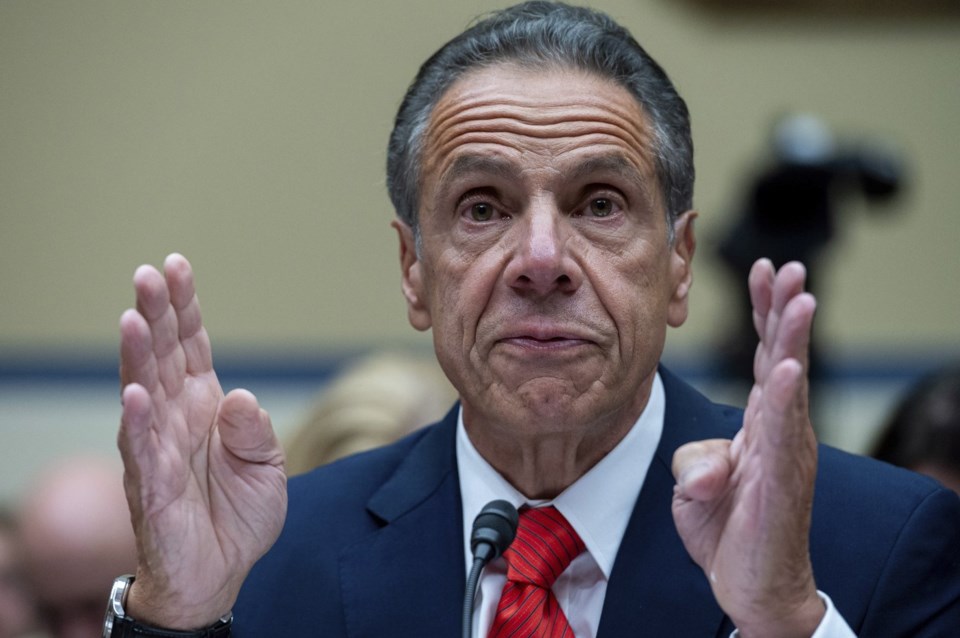Former New York Gov. Andrew Cuomo faced blistering criticism in an often combative congressional subcommittee hearing Tuesday over his handling of the COVID-19 pandemic during the time when the virus was spreading through nursing homes.
Republicans who questioned the Democrat zeroed in on a controversial directive his administration issued in March of 2020 that initially barred nursing homes from refusing to accept patients just because they’d had COVID-19. were released from hospitals into nursing homes under the directive, which was rescinded amid speculation that it had accelerated outbreaks.
U.S. Rep. Elise Stefanik of New York called the directive “deadly.” Rep. Brad Wenstrup, the Ohio Republican who chairs the House Select Subcommittee on the Coronavirus Pandemic, said it was inconsistent with federal guidance and its consequences were “dangerous and disastrous.” Republicans accused Cuomo of staging a cover-up to hide mistakes that endangered nursing home residents.
“Governor, you own this. It’s your name on the letterhead. This is your directive, whether you knew about it or not," Wenstrup said. “You’re the leader. The buck stops with you, or at least it should."
In over two hours of testimony, Cuomo adamantly defended his actions and blamed the former Trump administration for failing to provide enough testing and personal protective equipment in the early days of the pandemic.
“These are all diversions to blame New York and other states for the culpability of the federal response, which was malpractice,” Cuomo said.
The testimony is unlikely settle disputes over the nursing home order, which was issued to keep hospitals from becoming overwhelmed with COVID-19 patients who were no longer sick enough to require hospitalization but needed nursing home care for other conditions and couldn’t simply be discharged or sent home.
A report issued by the House committee didn't delve into the question of whether significant numbers of people discharged from hospitals were still contagious with the virus when they were readmitted to nursing homes, or whether they then passed the virus to other patients.
Some public health experts have said it is likely that most of the people who died in New York nursing homes during the early months of the pandemic got it from staff, from visiting loved ones, or from fellow patients who hadn't yet been hospitalized.
Cuomo told the panel that its report provided no evidence to support the allegation that the directive helped spread the virus.
“In fact, the report finds no causality whatsoever. Not one death,” he said.
In a particularly heated exchange, Stefanik asked Cuomo if he was negotiating a book deal as people in nursing homes were dying. They each accused each other of making up facts before Stefanik demanded Cuomo apologize to families who lost loved ones.
“There are families sitting here. I want you to turn around, look them in the eye and apologize, which you have failed to do," she said. "Will you do it?”
“This is not about political theater,” Cuomo responded.
The congressional committee said it had also determined that Cuomo and his top aides tried to deflect any potential blame by ordering up an unscientific report concluding that the rescinded March directive likely had little impact on fatalities.
There were about 15,000 COVID-19 deaths among long-term care residents in New York, far more than the initial number disclosed. Cuomo said some figures were initially withheld out of concerns about accuracy.
“The governor was desperate to change the narrative — to dispel of the notion that his administration failed nursing home residents,” said Republican Rep. James Comer, who chairs the House Oversight Committee.
Cuomo in August 2021 amid sexual harassment allegations, which he denies.
Cuomo was widely seen as a reassuring figure in the early months of the pandemic, but his reputation suffered after revelations that his administration released an incomplete accounting of the number of deaths at nursing homes and assisted living facilities.
Cuomo testified before the subcommittee in June but it was behind closed doors. Top former Cuomo administration officials also were interviewed as part of the investigation.
A separate state report commissioned by Cuomo's successor, Gov. Kathy Hochul, summer found that while the policies on how nursing homes should handle COVID-19 were “rushed and uncoordinated,” they were based on the best understanding of the science at the time.
Michael Hill, The Associated Press




